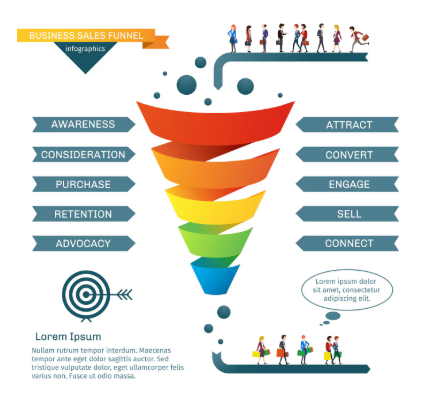Blog Detail
- Home
- Blog Detail

- July 28, 2025
Content Marketing Funnel: A Full Blueprint for Turning Attention into Revenue
A content marketing funnel turns strangers into loyal customers. It does more than share blog posts or tips. It builds direction into your content. Each step leads readers closer to a clear goal. With the right structure, your content becomes a system, not just a collection of ideas.
Every successful online business follows this approach. They attract attention and guide decisions with well-structured content. Instead of publishing randomly, they create each piece with intent and lead readers through a clear journey.
The content marketing funnel helps businesses grow with purpose. It helps teams stop wasting time on content that never converts. Instead, it leads people from curiosity to action. With the right strategy, each piece contributes more value, increases engagement, and fosters lasting trust.
In this blog, you’ll learn how to design and use your content marketing funnel to increase results, shorten the sales cycle, and connect your audience to your offer. We’ll move through each stage, show what works, and help you build a system that converts traffic into revenue, without guesswork.
What Is a Content Marketing Funnel?
The content marketing funnel is a step-by-step journey. It helps people move from strangers to customers by delivering the right content at the right time.
Every buyer starts at the beginning. They notice a problem or have a goal. As they search for answers, your content meets them where they are. The better you guide them, the more likely they are to choose your product.
The funnel has three main stages:
- Top of the Funnel (TOFU): Awareness
- Middle of the Funnel (MOFU): Consideration
- Bottom of the Funnel (BOFU): Decision
Each stage requires different types of content. Trying to sell too early can push people away. Instead, helping them move step by step builds trust and leads to sales.
Why the Content Marketing Funnel Works
Many businesses create content with no plan. They post random blogs or social media updates. As a result, they get traffic, but no leads or sales.
The funnel fixes that by:
- Attracting the right audience
- Keeping their attention with value
- Guiding them through their buyer journey
- Giving them confidence to take action
People don’t wake up ready to buy. They go through stages. When your content matches those stages, results follow.
Top of the Funnel (TOFU): Awareness Stage
TOFU stands for Top of the Funnel. This is the very first step in the funnel structure. At this stage, the goal is simple: introduce your brand and create awareness about the problem your target audience might be facing.
People at this point usually don’t know much about your services. They are not ready to buy. Instead, they are searching for helpful information, answers, or solutions to a problem. That’s why this phase focuses entirely on attracting attention through educational and engaging content.

TOFU Strategies That Work for Service-Based Brands
Creating useful content is key. Think of blogs, social media posts, short videos, podcasts, or free resources. Keep it informative and relevant to your audience’s needs. Avoid salesy language here. Instead, provide value to gain trust.
For example, if you run a digital marketing agency, share a blog about “Why Local SEO Matters for Small Businesses.” This positions your brand as helpful, not pushy. High-performing TOFU content answers questions, solves small problems, and encourages visitors to learn more.
Main objectives during TOFU:
- Increase website traffic
- Improve visibility through search engine rankings
- Build trust with valuable first impressions
- Collect basic user engagement data
Effective TOFU strategies rely heavily on SEO-friendly content. Use keywords that your audience searches for. Also, use internal links that guide visitors deeper into your website. This way, readers will naturally move toward the next stage of the funnel.
What to Avoid in TOFU
Don’t over-sell. Avoid technical jargon. Never assume the reader is already familiar with your services. Instead, present yourself as a helpful resource. Focus on raising interest and awareness.
Middle of the Funnel (MOFU): Consideration Stage
MOFU stands for Middle of the Funnel. Now that your audience knows who you are, the goal is to deepen their interest. People in this stage are evaluating different solutions and comparing options. They’re actively considering which company or service to trust.
This is where your brand must prove its worth. Share information that positions your services as a reliable solution to their needs. Case studies, in-depth blogs, free consultations, webinars, or email sequences work well here. These tools help build credibility and push potential customers closer to making a decision.
Best MOFU Tactics for Service Providers
At this point, people want more detailed content. They’re not just curious anymore—they’re interested. Offer real success stories, testimonials, downloadable guides, or detailed FAQ pages. Every piece of MOFU content should answer specific questions and highlight the benefits of your services.
For example, a legal firm might offer a free downloadable checklist titled “7 Things to Consider Before Hiring a Business Attorney.” This type of offer helps the visitor engage further and positions your team as the right choice.
Main objectives during MOFU:
- Nurture relationships
- Offer proof of service quality
- Increase lead generation
- Build deeper trust
Create email follow-up campaigns based on what content people interact with. Someone who downloaded a pricing guide may be ready for a discovery call. Use that behavior to your advantage and customize your follow-up approach.
What to Avoid in MOFU
Don’t confuse potential clients with too many offers. Stick to one goal per piece of content. Don’t push for a sale too early. Instead, focus on answering real questions. Guide them to feel confident that your service is the right match.
Bottom of the Funnel (BOFU): Decision Stage
BOFU means Bottom of the Funnel. This is where the lead turns into a customer. They’ve done their research, they know your brand, and now they’re ready to choose. At this point, your role is to help finalize the decision and remove any final doubts.
Decision-stage content should eliminate hesitation. Show them exactly what to expect. Offer free consultations, demos, pricing breakdowns, limited-time offers, or service guarantees. Provide all the information they need to feel confident before signing up.
BOFU Content That Converts
Strong calls-to-action (CTAs) are essential here. Tell the customer what to do next. “Book Your Free 30-Minute Consultation,” “Call Now to Get Your Custom Plan,” or “Start Your Project This Week” are effective and clear.
Live chat, client success videos, money-back guarantees, and customer reviews make a huge impact at this stage. These tools remove last-minute objections and speed up the buying decision.
Main objectives during BOFU:
- Close the sale
- Provide final assurance
- Answer any last-minute objections
- Make the process as smooth as possible
In this stage, even small changes can make a difference. Shorten your contact forms. Provide a phone number and calendar link for easy scheduling. Personal touches like “Your dedicated account manager will guide you from day one” help seal the deal.
What to Avoid in BOFU
Avoid unclear messaging. Don’t introduce new services or confuse the lead with different options. Keep it simple and direct. Reassure them they’ve made the right choice.
Building a Funnel: Step-by-Step Plan
Know Your Ideal Customer
Before writing a single word, define who your ideal customer is. What’s their age, profession, daily struggle, and long-term goal? Think like them. What makes them hesitate? What questions do they ask over and over? Write these down. Understanding this shapes your entire funnel—without it, you’ll waste time creating content no one cares about.
Plan for All Three Stages of the Funnel
Break your funnel into three parts: top (TOFU), middle (MOFU), and bottom (BOFU). For TOFU, focus on awareness—use blog posts, tips, and simple guides. In MOFU, your content should educate and nurture trust—try webinars, case studies, or comparison articles. BOFU is for closing—offer trials, live demos, pricing breakdowns, or testimonials. Match each stage to what your audience needs in that moment.
Write with Clarity
Don’t complicate things. Use short sentences, clear headlines, and plain language. Every line should move the reader forward. Avoid fluff. Readers today skim—they want answers fast. Clarity builds trust. Make your message obvious without over-explaining. Think like your reader. Would they read this and instantly “get it”? If not, rewrite.
Use Strong CTAs That Lead Somewhere
Each piece of content must have a job: push your reader to the next step. TOFU content? End it with “Download the Checklist” or “Read the Full Guide.” In MOFU? Suggest “Watch the Demo” or “Try the Free Sample.” For BOFU, go straight to action—“Buy Now” or “Start Free Trial.” Be bold. Your CTA isn’t just a button; it’s a nudge forward.
Promote Your Funnel Across Multiple Channels
Don’t just publish—promote. SEO brings organic traffic, but combine it with email marketing to reach your existing list. Run paid ads to re-engage visitors. Post regularly on social media. Use affiliate and referral links where possible. Each channel reinforces your funnel’s reach. Promotion makes your content visible, not invisible.
Track Results and Improve Constantly
Data keeps your funnel sharp. Use Google Analytics to track traffic flow and conversions. Hotjar shows where people drop off. Your email tool reveals which subject lines, buttons, and offers work best. Don’t guess—measure. Update underperforming pages. Swap weak CTAs. Test one change at a time, then refine again. This is how a funnel grows stronger.
Common Funnel Mistakes to Avoid
- No Strategy Behind Content – Each piece should move users forward.
- Selling Too Soon – Don’t pitch during awareness. You’ll lose trust.
- Skipping MOFU Content – Without it, readers may lose interest before they buy.
- Overusing Long-Form Content – Sometimes a checklist or short video works better.
- Ignoring Mobile Experience – Most users scroll on their phones.
- Forgetting Email Nurture Sequences – Follow up matters more than first clicks.
- Not Testing Offers – Try discounts, bundles, or free consultations.
Avoid these, and your funnel becomes a growth engine.
Final Words
The content marketing funnel is not just a theory. It’s a real-world tool that helps businesses win attention, grow trust, and increase conversions—step by step.
When you align your content with your reader’s mindset, magic happens:
- They discover your brand through helpful articles
- They stick around because you guide them with care
- They buy because you made the journey simple and clear
You don’t need more content. You need the right content at the right time.
Plan your funnel. Map your stages. Guide your visitors. Grow your sales.
If you’re ready to build a high-performing content funnel for your business, reach out. I can help you structure your strategy, write each content piece, and track results.
